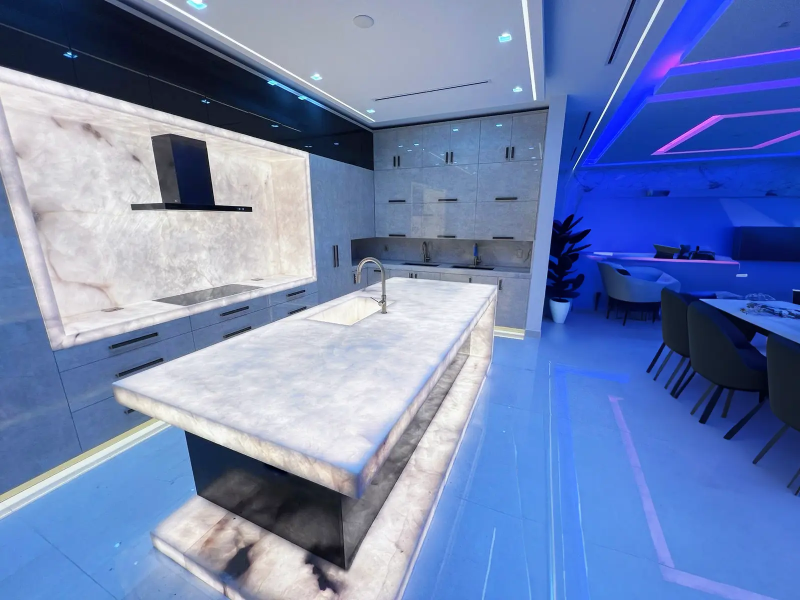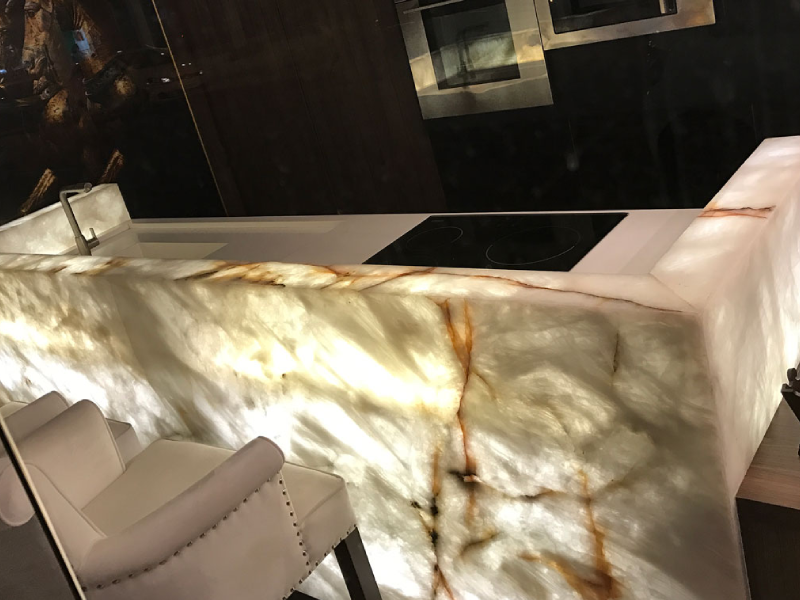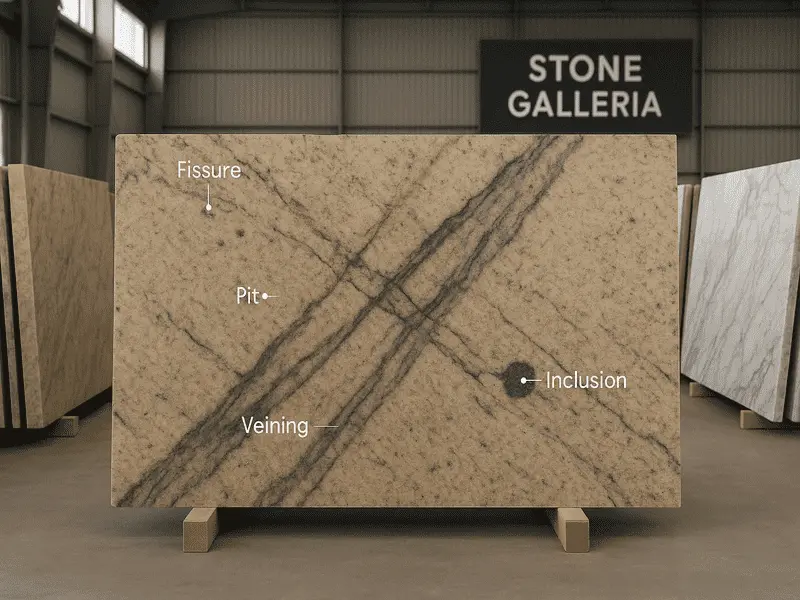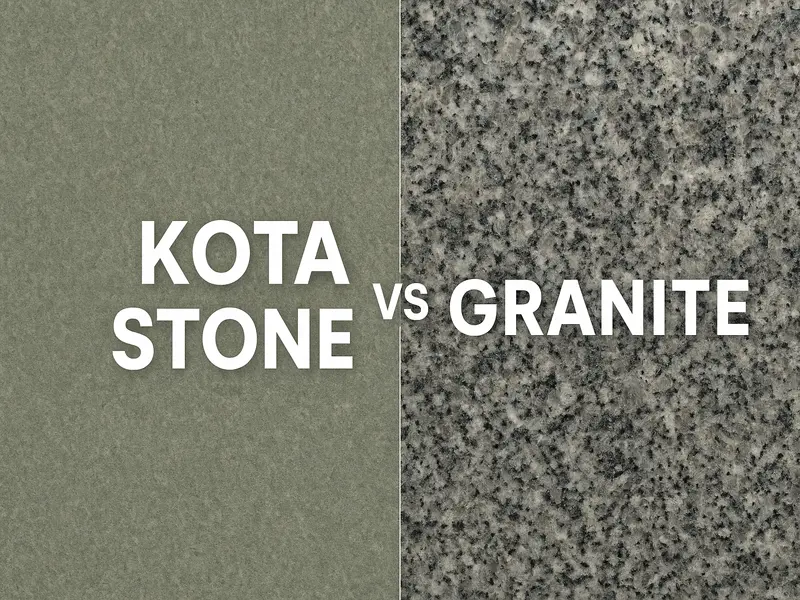Imagine walking into a room and seeing a soft, enchanting light glowing from the very walls and countertops. This isn’t a futuristic fantasy—this is the stunning effect of translucent stone slabs. If you’re looking for a unique and exciting way to add drama and ambiance to your home or business, these unforgettable stones are the perfect choice.

Translucent stone slabs are rare and exceptionally beautiful. They can turn any space into a piece of art, providing a captivating, glowing focal point that catches the eye and sparks conversation. Whether used as backlit countertops, glowing wall panels, or stunning room dividers, these stones bring a touch of elegance and intrigue to any setting.
Curious to learn more? Let’s dive into the world of translucent stone slabs and discover how they can transform your interior design. Let us first learn what are these translucent stone slabs?
What Is Translucent Stone Slab?
Translucent means that light can pass through a material, but the material is not completely clear. Think of it like a frosted glass window or a thin curtain. You can see light coming through, but you can’t see all the details on the other side clearly. This property gives translucent materials a soft, glowing effect when illuminated.
Translucent stone slabs aren’t a specific type of stone. Instead, they’re stones with special mineral properties that let light pass through. This gives them a unique and eye-catching glow. When backlit, their natural patterns stand out even more, creating a striking effect.
When I say translucent, the level of translucency can vary from one stone slab to another. One slab might be very translucent, while another from the same batch might not be translucent at all. This variation depends on many factors.
Are Translucency Levels the Same in All Stones?
Different types of translucent stones can vary a lot in how much light they let through. This difference comes from the stone’s density, structure, and mineral makeup. For example, stones like alabaster and onyx are well-known for their high translucency, meaning they allow a lot of light to pass through and create a bright, glowing effect. On the other hand, stones like marble and quartzite don’t let as much light through.
The thickness of the stone slab also affects how translucent it is. Thinner slabs usually let in more light, making the glow more intense. When designers and architects choose a translucent stone for a project, they consider these differences to achieve the right look and feel.

What Factors Affect How Translucent Stone Slabs Are?
The translucency of stones depends on their makeup and structure. Stones like onyx, alabaster, and some types of marble have a more open and porous structure that allows light to pass through, giving them a translucent effect. Several factors influence this:
- Mineral Composition: The types of minerals in the stone can affect how much light passes through.
- Crystal and Density Structure: tones with specific crystal structures, like onyx, can reflect or scatter light internally, making them more translucent. Additionally, stones with a more open or less dense structure allow light to pass through more easily, while dense, tightly-packed stones block more light.
- Optical Properties: Some minerals have special qualities that let light shine through better.
- Color and Impurities: The color of the stone and any impurities can also impact its translucency.
- Formation Process: How the stone was formed can impact its translucency. Stones that formed under certain conditions might have more natural gaps or variations that allow light to pass through.
- Surface Finish: The way a stone is finished can also affect its translucency. Polished or smooth surfaces can enhance the light transmission compared to rough or textured finishes.
Backlighting these stones makes their natural patterns and colors stand out even more. On the other hand, stones that are denser and more opaque don’t have these qualities and therefore don’t become translucent.
Understanding Translucent Stone Slabs
Translucent stone slabs possess distinctive characteristics that set them apart in architectural and design contexts. Here are key features of translucent stone slabs:
Light Transmission: The primary characteristic is their ability to transmit light, creating a unique visual effect when backlit. This quality adds a luminous and ethereal quality to the stone.
Material Variety: Translucent stone slabs are crafted from a variety of natural stones, such as onyx, alabaster, and marble. Each material contributes its own color variations and veining patterns.
Color Play: When illuminated, these slabs exhibit a captivating play of colors, emphasizing the natural variations within the stone. This dynamic color display can be customized based on the type of stone and lighting used.
Texture and Grain: The inherent texture and grain of the natural stone are preserved, contributing to the overall aesthetics. The translucency enhances the visibility of these natural characteristics.
Versatility: Translucent stone slabs are versatile in their applications, suitable for a range of interior and exterior design elements, including feature walls, countertops, and lighting fixtures.
Thickness Options: They are available in various thicknesses, allowing for flexibility in design and application. Thinner slabs may be more suitable for certain uses, while thicker slabs provide depth.
Customizable Lighting: The effect of translucency can be adjusted through customizable lighting options. Different intensities and colors of light can be used to achieve the desired ambiance.
Natural Beauty: Retaining the natural beauty of the stone, translucent slabs offer a harmonious blend of organic elegance and modern functionality.
Understanding these characteristics allows designers and architects to leverage the unique qualities of translucent stone slabs in creating visually stunning and atmospheric spaces.
How is a Translucent Slab Backlit?
The process starts with planning where you want to install the stone. To backlight a translucent slab, a light source is placed behind it, usually LED lights because they provide a steady, even glow. The light shines through the slab, enhancing its natural patterns and creating a striking effect. This setup makes the slab stand out and adds a beautiful touch to any space.
Different Types of Translucent Stone Slabs
Various types of translucent stone slabs are available, each with its own mineral composition, color variations, and visual effects when backlit. Here are some popular types:
Onyx Slabs
Onyx Slabs are a great example of how transparency and beauty come together. Onyx slabs are beautiful when lit up from behind, creating a glowing effect in rooms.
Alabaster Slabs
Alabaster Slabs are smooth and let light through, making rooms feel calm and bright. These slabs are often used in fancy lights, glowing panels, and even detailed sculptures, making interiors look more elegant.
Quartzite Slabs
Quartzite Translucent Slabs combine the beauty of see-through qualities with the strong durability of natural stone. These tiles can be used for many different things, like covering the outside of a building or creating beautiful decorations that sparkle in the light.
Marble Slabs
Marble, a type of natural stone, can become see-through when it is cut into thin pieces. Some marbles, such as Calacatta and Carrara, have a unique pattern of lines that can be seen more clearly when light shines through them from behind. You can create beautiful and functional vanity tops, shower enclosures, and accent walls using this technique.
Agate Slabs
Agate is a type of stone that has pretty patterns and can be see-through or not. It is translucent because of its microcrystalline structure, which allows light to pass through.
Quartz Slabs
Certain types of quartz, like rose quartz and smoky quartz, may look somewhat see-through due to impurities or inclusions.
Also READ | The Reason for Material Selection: Engineered Stone Vs Natural Stone
Translucent Granite Slabs
There are only a few granites that are only semi-translucent in nature.
When choosing a type of translucent stone slab, considerations such as color preference, desired level of translucency, and the intended application play a crucial role in achieving the desired aesthetic in architectural and design projects.
Applications of Translucent Stone Slabs
Translucent stone slabs find diverse applications in architectural and interior design, adding a touch of elegance and sophistication to various spaces. Here are common applications of translucent stone slabs:
Feature Walls
Translucent stone slabs are often used to create captivating feature walls. When backlit, they transform ordinary walls into focal points, providing a dynamic and visually appealing backdrop.
Translucent Countertops
Architects and designers really like using backlit stone slabs on countertops because they look unique and plus. These slabs make kitchens and bathrooms look shiny and fancy, making daily tasks feel more luxurious and enjoyable. The soft glow they emit enhances the overall ambiance of these spaces.
Bar Tops and Entertainment Area
Bars and entertainment areas benefit from the use of translucent stone slabs for their bar tops. The play of light adds a touch of glamour to the setting.
Staircase Balustrades
Incorporating translucent stone slabs into staircase balustrades lends a modern and luxurious look. The translucency enhances the visual interest of the stairwell.
Reception Desks
In commercial spaces, reception desks made from translucent stone slabs make a bold statement. The gentle glow creates a welcoming and sophisticated environment.
How Does a Translucent Stone Slab Look Without Being Backlit?
Without backlighting, a translucent stone slab looks more like a traditional, solid stone surface. The unique ability to let light through isn’t visible, so the stone appears more opaque. You’ll see the natural colors, patterns, and veining of the stone, but it won’t have the glowing effect that backlighting provides. The stone’s appearance will be more subdued, showing its texture and color but lacking the vivid light and depth seen when illuminated from behind.
Are Translucent Slabs Expensive?
Yes, translucent slabs are more expensive than standard stone slabs, and for good reasons. They are rare, in high demand, and offer a unique, luxurious appearance that serves as a stunning focal point. The ambiance and beauty they add to any space make them worth every penny.
Conclusion
In conclusion, translucent stone slabs offer a unique way to enhance any space with their ability to let light pass through and create a stunning, glowing effect. Whether using onyx, alabaster, or other types of translucent stones, these slabs bring a rare and luxurious touch to your design. The backlighting process, involving carefully installed LED lights, highlights the natural beauty of the stone and ensures a captivating visual impact. Though they can be more expensive than standard stones, their distinctive appearance and the ambiance they create are well worth the investment.


 Fact Checked
Fact Checked









![Latest GST on Granite Slabs & Blocks [2025 Chart + HSN + Price Examples]](https://stonegalleria.in/admin/images/blog/latest-gst-on granite.webp)




